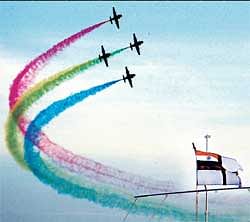Phantoms celebrate golden jubilee, firmly rooted in Goa

By an intriguing coincidence, this is also the year of the golden jubilee celebrations of Goa’s Liberation. Commissioned on September 5, 1961 INS Hansa shifted base from Sulur, near Coimbatore, to Dabolim in June 1964, laying claim to an airport that had been hastily abandoned by the Portuguese after December 19, 1961.
After the departure of the British, the Indian Navy began to assemble its aviation wing in the early 1950s with the acquisition of the piston engine Sealand amphibian Firefly Target Tugs bought from the UK and HT-2 trainers from Hindustan Aeronautics Limited (HAL).
By September 1958 three Vampire fighter jets from HAL and a trainer aircraft loaned from the Indian Air Force formed the early Naval Jet Flight (JTF) quartet stationed at Sulur.
Soon after, the Navy began to put together its first combat squadron, INAS 300 or ‘White Tigers’ with the training of Indian pilots at the Royal Navy air station at Brawdy, Wales.
“In the autumn of 1959 the Indian Navy placed an order for 24 Armstrong Whitworth Sea Hawk FGA Mk 6 for the fighter-bomber role. Indian naval aviation had finally begun to take on tangible form,” writes an ex-navyman in the ‘Purple Beret’.
Squadron 300 commissioned at Brawdy in 1960 in the presence of then Indian High Commissioner Vijayalakshmi Pandit, celebrated its golden anniversary in Goa last year.
Still in its formative years, naval aviation, too, played a role in Goa’s liberation. By end July 1961 when 11 Sea Hawks flew off from Brawdy to embark on the INS Vikrant off the Isle of Wight, Nehru was still mulling over a decision for military action against the Portuguese in Goa. A few weeks after it touched Mumbai in November 1961, India’s only aircraft carrier and its new combat squadrons were requisitioned for Operation Vijay to liberate Goa.
While the Navy struck at sea and provided a strong deterrent to ‘foreign intervention’ the IAF’s bombing of Dabolim airport defanged the Portuguese intent to fly in more troops into Goa. Two raids on December 18 targeted the runway, but left the terminal and other facilities undamaged.
Two Portuguese transport aircraft still managed to evacuate some government and military officials and families to Karachi, using the cover of night. Indian military personnel later found plane seats strewn on the runway. The Portuguese pilots had offloaded all the extra seats and other unwanted equipment so that they could do a “short take-off” on the bombed out airstrip.
After Goa’s liberation, the Navy began to relocate its airbase to Dabolim. Hansa has seven squadrons based here, the 300 that flies Sea Harriers, 310 with the Dornier-228, 315 for the IL-38SD, 339 which operates the Kamov-31 helicopter, 551 that have the HJT-16 Kirans, 552 on the Sea Harrier trainers and the recently formed Black Panthers for the MiG-29K inducted in February 2010.
Hansa is the navy’s largest airbase in India. But Dabolim is also Goa’s only civilian airport which operates today as an enclave of the naval facility. Defence requirements of land and security restrictions have often been in conflict with Goa’s interests as a tourist destination. Though the Centre has cleared a new airport project for Goa, delivery seems years away.
There is enormous congestion at Dabolim today both inside and outside the airport, making it one of the most chaotic in the country. Given its strategic location on the West Coast, the Navy says Hansa, its premier air station in the country, will not shift out of Goa.
Deccan Herald is on WhatsApp Channels| Join now for Breaking News & Editor's Picks